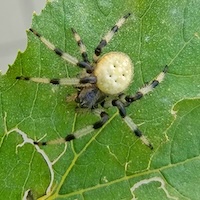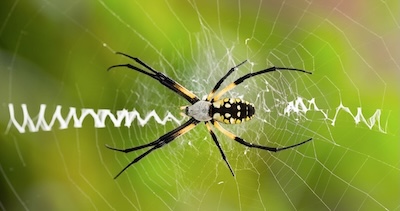Araneidae: Difference between revisions
No edit summary |
No edit summary |
||
| Line 4: | Line 4: | ||
{| class="wikitable" style="text-align:center; float:right; margin-left: 12px; | {| class="wikitable" style="text-align:center; float:right; margin-left: 12px; | ||
|- | |- | ||
|colspan="2" |[[File: | |colspan="2" |[[File:Shamrock orb-weaver.jpg|201px|thumb|Shamrock Orb-weaver Full Body View]] | ||
|- | |- | ||
|+ !colspan="2" style="min-width:12em; text-align: center; background-color: rgb(235,235,210)|'''Scientific Classification''' | |+ !colspan="2" style="min-width:12em; text-align: center; background-color: rgb(235,235,210)|'''Scientific Classification''' | ||
| Line 37: | Line 37: | ||
[[File: | [[File:Orb-weaver spider web.jpg|570px|thumb|Center of Orb-weaver spider web]] | ||
==Webbing Habits== | ==Webbing Habits== | ||
Orb-weaver spiders (family Araneidae) are known for their intricate, wheel-shaped webs, which they construct using a highly methodical process. Web building typically begins with the spider releasing a silk thread that catches onto a surface via the wind, forming a bridge line. The spider then reinforces this initial line and descends to create a Y-shaped framework, which serves as the base of the web. It continues by constructing radial spokes outward from a central hub, much like the spokes of a bicycle wheel. Next, the spider lays down a temporary spiral from the center outward to space the radial lines, followed by the final sticky capture spiral, which it builds inward toward the hub. This spiral is coated with adhesive droplets to trap prey. Most orb-weavers rebuild their webs daily, usually at dusk or dawn, and consume the old silk to recycle its proteins. [5] | |||
Orb-weaver spiders are strategic about web placement, typically building in open spaces between branches, across paths, or near lights where flying [[insects]] are abundant. They often select locations with minimal wind and sufficient anchor points to support the web’s radial structure. The position also varies by species—some prefer low vegetation, while others suspend their webs high in the canopy or on man-made structures. The goal is to maximize prey capture while minimizing damage from environmental factors. [3] | |||
Web rebuilding is common and serves several purposes. These spiders usually dismantle and consume their webs daily, often in the early morning or evening, to reclaim the silk proteins, which are energetically costly to produce. Environmental wear, dust accumulation, and reduced stickiness also degrade a web’s effectiveness over time. Rebuilding ensures the web remains optimally positioned and fully functional for catching prey. Additionally, by varying web position slightly each day, orb-weavers may avoid becoming predictable to predators or parasitic insects that exploit stable web sites. [4] | |||
==References== | ==References== | ||
[1] Bern, Museum. “NMBE - World Spider Catalog.” Nmbe.ch, 2025, wsc.nmbe.ch/statistics/. | [1] Bern, Museum. “NMBE - World Spider Catalog.” Nmbe.ch, 2025, wsc.nmbe.ch/statistics/. | ||
[2] “Orb Weaver Spider Control: Facts, Control & Tips – Aptive Environmental.” Aptive Environmental, 31 Aug. 2024, aptivepestcontrol.com/pests/spiders/orb-weaver-spiders/orb-weaver-spider-control-facts-control-tips/#:~:text=One%20of%20the%20defining%20characteristics,giving%20them%20an%20unmistakable%20appearance. | |||
[3]“How Do Spiders Choose Where to Spin Their Webs?” Assured Environments, 5 Sept. 2024, www.assuredenvironments.com/blog/how-do-spiders-choose-where-to-spin-their-webs/. | |||
| |||
[4]Taras, Zach. “The Orb Weaver Spider Consumes Its Own Used Webs.” HowStuffWorks, 14 Jan. 2025, [[animals]].howstuffworks.com/arachnids/orb-weaver-spider.htm?. | |||
| |||
[5] Eberhard, William G. “Behavioral Characters for the Higher Classification of Orb-Weaving Spiders.” Evolution, vol. 36, no. 5, Oxford University Press (OUP), Sept. 1982, p. 1067, https://doi.org/10.2307/2408084. | |||
| |||
Revision as of 13:25, 30 April 2025
Araneidae, orb-weaver spiders, are the largest group of orb-web-building spiders. The Araneidae family currently has 3,152 species and is the third largest family of spiders after Salticidae (Jumping spiders) and Linyphiidae (Sheet weaver spiders). [1]
 | |
| Domain: | Eukaryota |
|---|---|
| Kingdom: | Animalia |
| Phylum: | Arthropoda |
| Subphylum: | Chelicerata |
| Class: | Arachnida |
| Order: | Araneae |
| Infrarder: | Aranemorphae |
| Family: | Araneidae |
Description
Orb-weaver spiders are often identified by their brightly colored / patterned bodies. Araneidae have rounded abdomens that are used for storing food and producing silks. They also have characteristically elongated legs that aid in maneuvering across their webs. Near the bottom of the orb-weaver's abdomen, there are spinnerets present. Spinnerets are specialized organs that produce the silk threads for web constructions. Orb-weavers typically have three pairs of spinnerets, each having a specific job in the creation of the orb-weaver’s intricate webs. Orb-weavers vary greatly in size; large species of Orb-weavers can average 1-5 inches in size, while smaller species of Orb-weavers can average 1-8 centimeters in size.

Webbing Habits
Orb-weaver spiders (family Araneidae) are known for their intricate, wheel-shaped webs, which they construct using a highly methodical process. Web building typically begins with the spider releasing a silk thread that catches onto a surface via the wind, forming a bridge line. The spider then reinforces this initial line and descends to create a Y-shaped framework, which serves as the base of the web. It continues by constructing radial spokes outward from a central hub, much like the spokes of a bicycle wheel. Next, the spider lays down a temporary spiral from the center outward to space the radial lines, followed by the final sticky capture spiral, which it builds inward toward the hub. This spiral is coated with adhesive droplets to trap prey. Most orb-weavers rebuild their webs daily, usually at dusk or dawn, and consume the old silk to recycle its proteins. [5]
Orb-weaver spiders are strategic about web placement, typically building in open spaces between branches, across paths, or near lights where flying insects are abundant. They often select locations with minimal wind and sufficient anchor points to support the web’s radial structure. The position also varies by species—some prefer low vegetation, while others suspend their webs high in the canopy or on man-made structures. The goal is to maximize prey capture while minimizing damage from environmental factors. [3]
Web rebuilding is common and serves several purposes. These spiders usually dismantle and consume their webs daily, often in the early morning or evening, to reclaim the silk proteins, which are energetically costly to produce. Environmental wear, dust accumulation, and reduced stickiness also degrade a web’s effectiveness over time. Rebuilding ensures the web remains optimally positioned and fully functional for catching prey. Additionally, by varying web position slightly each day, orb-weavers may avoid becoming predictable to predators or parasitic insects that exploit stable web sites. [4]
References
[1] Bern, Museum. “NMBE - World Spider Catalog.” Nmbe.ch, 2025, wsc.nmbe.ch/statistics/.
[2] “Orb Weaver Spider Control: Facts, Control & Tips – Aptive Environmental.” Aptive Environmental, 31 Aug. 2024, aptivepestcontrol.com/pests/spiders/orb-weaver-spiders/orb-weaver-spider-control-facts-control-tips/#:~:text=One%20of%20the%20defining%20characteristics,giving%20them%20an%20unmistakable%20appearance.
[3]“How Do Spiders Choose Where to Spin Their Webs?” Assured Environments, 5 Sept. 2024, www.assuredenvironments.com/blog/how-do-spiders-choose-where-to-spin-their-webs/. [4]Taras, Zach. “The Orb Weaver Spider Consumes Its Own Used Webs.” HowStuffWorks, 14 Jan. 2025, animals.howstuffworks.com/arachnids/orb-weaver-spider.htm?. [5] Eberhard, William G. “Behavioral Characters for the Higher Classification of Orb-Weaving Spiders.” Evolution, vol. 36, no. 5, Oxford University Press (OUP), Sept. 1982, p. 1067, https://doi.org/10.2307/2408084.